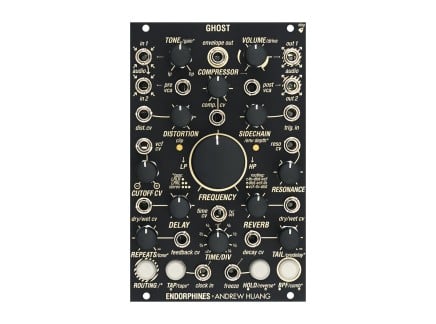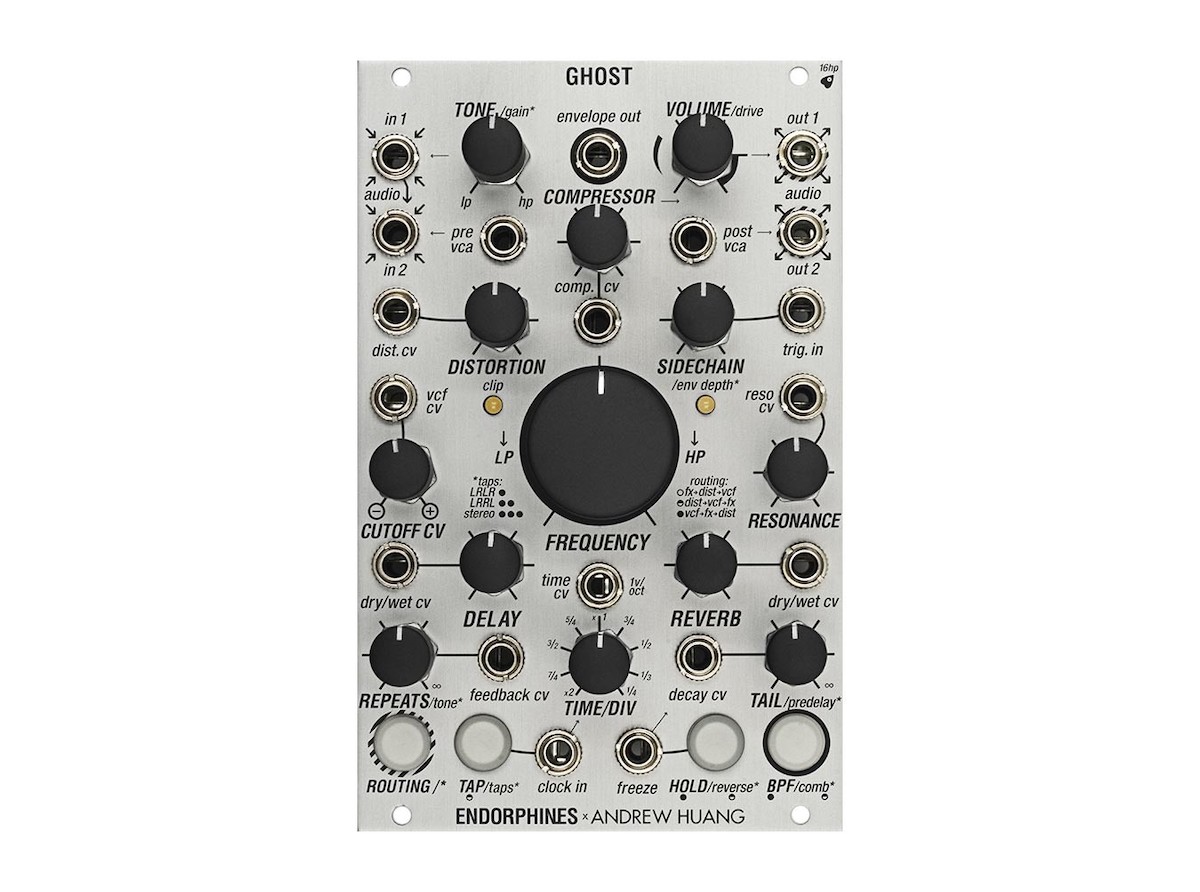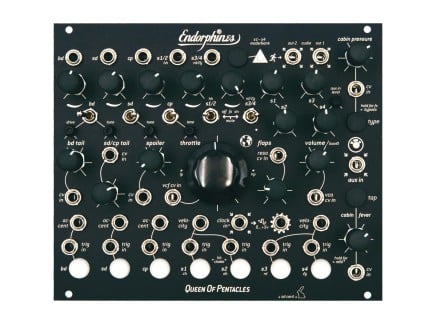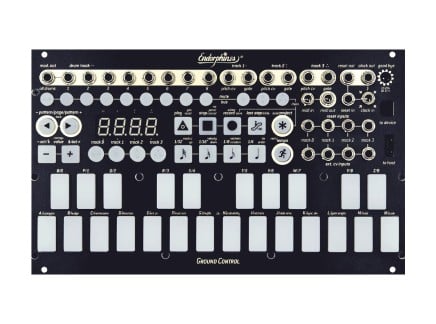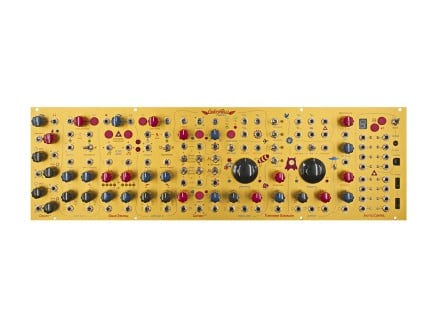These days, we find ourselves being particularly captivated by the powerful effects processors hitting the Eurorack market. As much as we love a good oscillator or filter, hearing a patch smeared, mangled, and destroyed by an ear-catching effects module always takes things to a whole new level. And as DSP power increases and coding chops are refined, these modules are getting better and better, year after year.
With this in mind, GHOST, first announced by Endorphin.es at Superbooth 2022, is pretty exciting in itself, but we were pretty blown away when we discovered that they teamed up with Andrew Huang to design it. The fact that it's a powerful and flexible stereo multi-effects module is truly the icing on the cake.
If you want more news from Superbooth, be sure to check out our full Superbooth 2022 Coverage article. Here, though, we're going to take some time breaking down what GHOST has to offer, while talking a little bit about why artist and synth maker collaborations like this always get us hyped up.
Artist + Synthesizer Collaborations
Ghost isn't the first time we've seen a synthesizer brand work with an artist in realizing their specific visions in a product. Due to their inherent complexity, synths and Eurorack modules are an interesting alternative to other sides of the musical instrument industry, where a lot of things like artist signature guitars, pedals, and the like are usually rooted as a modification of an existing product. There are exceptions of course, but more times than not with electronic music gear it often makes more sense to build something totally new from the ground up.
In the Eurorack world, we've recently seen this with Ben Wilson, also known as DivKid, and his work with brands like Befaco, Instruo, and Steady State Fate. With someone like DivKid that has such a depth of knowledge of Eurorack modules, his perspectives on module functionality are a valuable asset to module designers, and he has picked the companies he's worked with based on how their particular strengths align with his vision. And based on the success of modules like Ochd and the new Stereo Strip—we're inclined to believe that synthesists across the world agree.
Another example is the partnership of Make Noise and Alessandro Cortini, and their resulting semi-modular platform for sonic alchemy: Strega. Cortini's music has a strong identity, and his past use of quirky analog gear, including an extensive history of performing and recording with Make Noise systems, and that surely played a big role in designing Strega. But even so, synthesizers are so flexible and open-ended that while anyone could pick up a Strega and approach Cortini's sonic territory, there's so much breadth in the sounds that it's not an instant Cortini-soundalike-box—it's easily possible for your own, unique musical identity to come through.
So as one could imagine, hearing the news of a collaboration between Andrew Huang and Endorphin.es got us quite excited. Huang's eclectic musical output and informative musical content have shown a strong inclination (and love) for combining crisp production with some of the most interesting and bizarre sounds imaginable—and having a whole lot of fun while doing it. He has quite an affinity for highly flexible tools that continue to inspire and yield usable results, whether for music and sound design. Thus, teaming up with Endorphin.es, who have quite a history of crafting dense modules with both powerful featuresets and phenomenal sound, makes perfect sense.
GHOST: Truly Modular Multi-Effects
Its clear that Andrew Huang must have been drawn towards the Endorphin.es effects modules, because in some ways GHOST is both a "greatest hits" collection and unique extension of prior algorithms. Putting it simply: GHOST is a fully stereo audio processor, with extensive CV capabilities and a number of different routings for its digital effects blocks. This makes GHOST the best of both worlds—a highly capable single unit for multi-effects processing that still subscribes to the best parts of a modular workflow.
Between the compressor, filter, and delay + reverb sections, there's a lot to unpack here—even beyond the effects themselves. Under the hood, Endorphin.es packed in a powerful ARM Cortex M7 to be the brain of GHOST, with the audio processing running at 96kHz sample rate and 32-bit depth. That means there's plenty of power for all kinds of applications as demanding as Andrew Huang, or anyone else, could every require, at least within the context of a modular patch. At the surface, 19 patch points, 13 knobs, and four buttons provide abundant control and flexibility, opening the onboard effects up to extensive manual and voltage control manipulation.
What about the effects themselves? Looking at the Routing notes on the front panel, GHOST divides its effects into three groups: FX (delay and reverb), Dist (distortion), and VCF (filter), but there's also a compressor with sidechaining, and pre and post VCAs. The delay may be tapped manually or clocked from an external source, supporting times up to two and a half seconds in length. For further time displacement mayhem, the clock rate may be divided or multiplied or even controlled with 1v/Oct sequences. Meanwhile, the reverb offers two new algorithms: a supremely lush hall or interesting reverse, offering controls for predelay, freeze, and more.
GHOST's distortion effect uses an algorithm with eight-times oversampling, meaning its ready to handle intense overtones and harmonic spectra without giving back and nasty artifacts. Finally, a state-variable filter is on hand to clean up any mess in the high-end or low-end, regardless of where it appears in GHOST's signal chain. To that end, the Routing button supports three different effect paths, rearranging the FX, Distortion, and VCF blocks as needed for your patches. Yet on top of this, you still have the pre and post VCAs, as well as the compressor to squish everything and trigger sidechain pumping with the internal ducking envelope—which can also be routed out to other places in your system.
Don't Give Up the GHOST
Modular synthesizers are one of the most interesting platforms to explore effects processing. Even as guitar pedals get crazier and wackier, being able to freely route signals, both for audio and control purposes, is big part of the appeal for Eurorack modules like GHOST. And with powerful DSP running everything behind the scenes, the effects themselves are only going to get crazier from here on out. And again, we're so pleased to see Andrew Huang and Endorphin.es working together and bringing wild ideas to life—and we hope this opens the door for conversations between other artists and synth designers.

